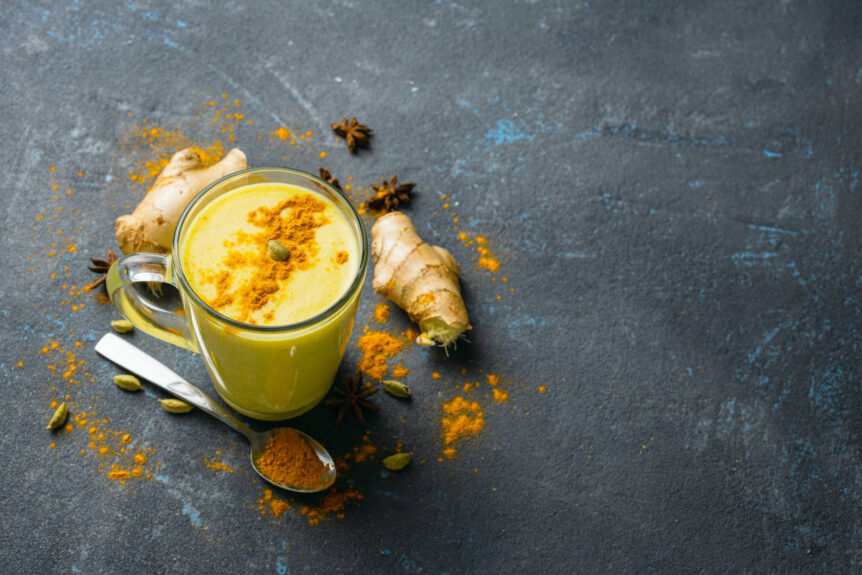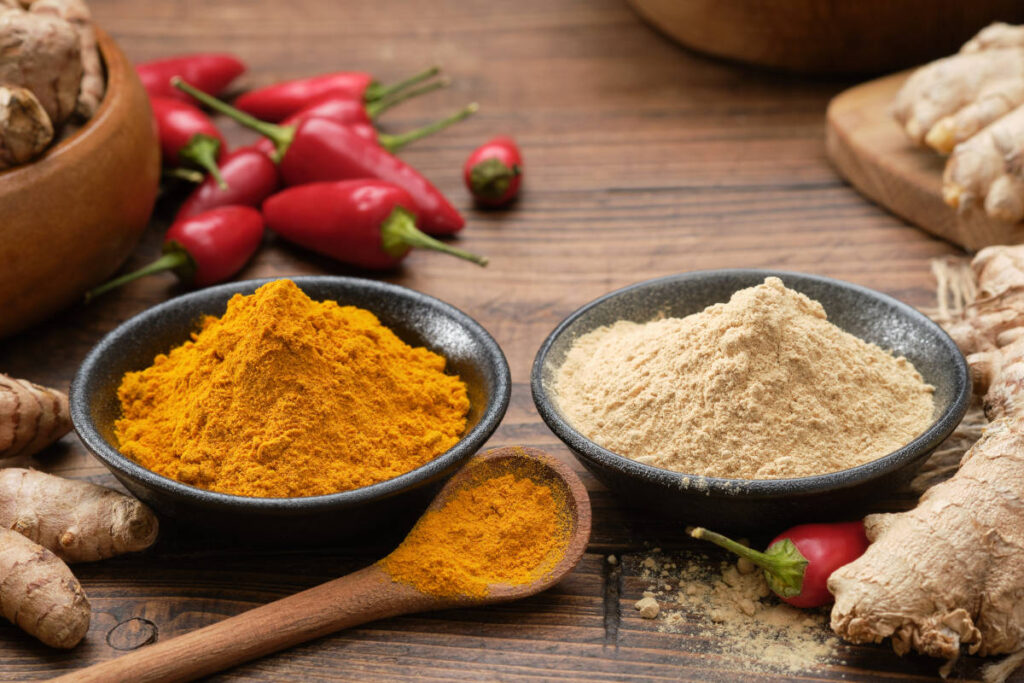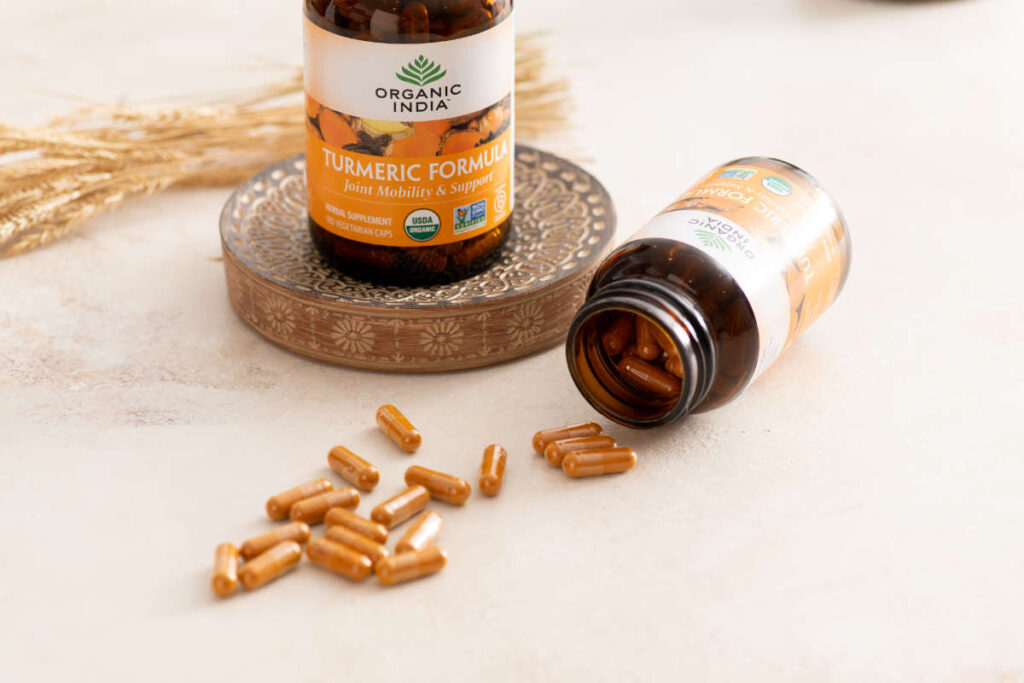

Section

Back
Turmeric Vs. Ginger: Differences, Uses, & Benefits
02/06/2024 | Written by Kristen Boye
Herbal Secrets

Are you curious about the differences between Ginger vs. Turmeric?
Although these two rhizomes may look similar, their uses in Ayurveda and other traditional herbal and culinary practices are quite different.
Read on to learn more about Turmeric vs. Ginger, including what makes them different, their traditional uses in Ayurveda, their individual and combined benefits, which one works best for inflammatory response, and much more.
Are Ginger and Turmeric the Same Plant?
At first glance, Ginger and Tumeric look quite similar.
Both are roots/rhizomes with tan skin and a meandering finger-like appearance.
They even come from the same family of plants, the Zingiberaceae (i.e., ginger) family, and are native to Southeast Asia.
However, once you peel back the skin, their vastly different colors and scents make clear these are two entirely different spices.

What is Better, Turmeric or Ginger?
Turmeric and Ginger are both prized in Ayurveda for supporting similar and different aspects of well-being.
Asking which one is better would be like asking a parent to choose between their favorite child! Both are equal in terms of value, but they have different strengths.
Let’s start with what Turmeric and Ginger have in common:
- Both have been used and shown to support normal inflammatory response.
- Both have been used, and studies suggest they may promote normal cardiovascular function.
- Both have been used and shown to support metabolic function.
- Both have been traditionally used to support immune function.
Turmeric and Ginger are also both used staples in traditional Ayurvedic and Indian culinary arts.
As previously mentioned, Turmeric and Ginger also have individual benefits and uses and may be combined in traditional herbal formulas.
For example, Ginger contains various active plant compounds, including Gingerols and multiple antioxidants, which research suggests may support the following:
- Cognitive function
- Immune function
- Digestive function, including nausea and morning sickness during pregnancy
- Menstrual cramps
- Normal sugar metabolism/metabolic function
- Respiratory function (Ginger is considered an expectorant in traditional herbalism)
- Thyroid Function
Turmeric and its active component, Curcumin, are most well-known for their inflammatory-response properties. Turmeric has also been shown to support the following:
- Cognitive function
- Immune function
- Inflammatory response and minor pain management
- Liver function
- Normal sugar metabolism
- Skin health
The more we learn about these two plants, the more it starts to validate their individual and combined use in traditional Ayurvedic herbalism.

Is it safe to take turmeric and ginger together?
As you’ve probably gleaned from the information provided so far, it is safe and often advisable to take Turmeric and Ginger together.
Many traditional Ayurvedic formulas combine the two for things like cognitive support, digestive support, minor pain management, and metabolic function.
Since research suggests Turmeric and Ginger may have an effect on blood sugar, talk to your healthcare practitioner before taking them alone or in combination.
Turmeric vs Ginger for Healthy Inflammatory Response
As discussed previously, studies suggest both Ginger and Turmeric may support normal inflammatory response and be helpful for minor pain management.
So, which is better?
There is ample research to support the use of both.
However, Turmeric and its active component, Curcumin, have the most evidence behind their use to date (Turmeric is one of the most-studied herbs on the planet!).
In Ayurveda, they are often combined, such as the classic Golden Milk formula, to take advantage of each herb’s inflammatory-support properties.
However, the inflammatory response covers a large scope of bodily functions.
Therefore, Ayurvedic practitioners may recommend just one of the herbs depending on the person’s dosha (not everyone benefits from the warming effects of Ginger, for example) and specific health concerns.

Turmeric vs. Ginger for Digestive Support
Most people associate Ginger more strongly with digestive support. However, as previously mentioned, both herbs are used in Ayurveda for this purpose.
The most robust scientific evidence lies with Ginger, which has been shown to support various aspects of digestive function and even help with nausea, motion sickness, and morning sickness during pregnancy.
The evidence in favor of Turmeric points more to its effects on liver function (the liver produces bile, for example, which is critical to digestion), microbiome support, and inflammatory response—including that of the GI tract.
Ayurvedic practitioners use both herbs to support different aspects of digestive function such as digestive fire, bile production, gut health, etc.
The right herb for an individual would depend on various factors, including the person’s presentation, dosha, and health goals.
Combined Benefits of Turmeric and Ginger
As we’ve discussed, Turmeric and Ginger can be a powerful pair when combined to support the following:
- Normal immune function
- Normal inflammatory response
- Digestion
- Cognitive function
- Liver function
- Microbiome health
- Metabolic function
- And for minor pain management
For this reason, you may see Turmeric and Ginger combined in many different Ayurvedic supplements and teas.
For example, Organic India’s Turmeric Formula pairs Turmeric with Ginger, plus Long Pepper and Black Pepper to support nutrient assimilation, inflammatory response, and a healthy gut microbiome.*
Our Tulsi Turmeric Ginger Tea combines adaptogenic Tulsi with the inflammatory- and immune-supportive duo of Turmeric and Ginger for a full-spectrum wellness tea that will warm and energize your whole body.
Golden Milk is another example of an Ancient Ayurvedic tonic that combined Turmeric with Ginger and other digestive-loving herbs and spices.
Turmeric vs. Ginger Taste
Turmeric and Ginger have very different flavor profiles.
Turmeric is more earthy and astringent, while Ginger is hot and pungent.
Their contrasting flavors are part of what makes them so complementary in the culinary arts, where they’re often combined in curries, soups, stews, marinades, and various Indian and Asian recipes.

How to Get More Turmeric and Ginger in Your Diet
As you’ve just learned, Turmeric and Ginger both bring a wealth of culinary and wellness benefits.
The ancient Vedics understood this, which is why both spices are foundational to Ayurvedic herbalism and wellness practices.
Both spices are widely available today in supermarkets, spice aisles, teas, and as supplements.
Turmeric can be added to almost any dish in small amounts (its flavor can quickly become overpowering) to impart flavor and a beautiful golden color.
If you don’t care for the taste of Turmeric, you can try it as a supplement, like Organic India’s Turmeric Formula, a tea, or in Golden Milk.
Ginger adds considerable zing to various dishes and maybe a more familiar flavor than Turmeric.
Fresh Ginger can also be grated and made into tea or Ginger water with the addition of lemon and honey.
Since Ginger is so spicy, many people may prefer to take it as a supplement or herbal tea, such as Organic India’s Tulsi Lemon Ginger tea.
However you choose to enjoy them, consider consuming them regularly (like the Vedics do) for best results.






 Kristen Boye is a freelance natural health and green living writer, copywriter, and editor. Kristen was raised on an organic farm in British Columbia which inspired her life’s work. She holds a Bachelor’s Degree in Natural Health, is a Certified Natural Foods Chef, a medicinal herb farmer, natural foods advocate, and is obsessed with writing, homesteading, researching, regenerative agriculture, and words in general. Kristen lives with her husband and two children on their medicinal herb farm in Western North Carolina. Visit her online at:
Kristen Boye is a freelance natural health and green living writer, copywriter, and editor. Kristen was raised on an organic farm in British Columbia which inspired her life’s work. She holds a Bachelor’s Degree in Natural Health, is a Certified Natural Foods Chef, a medicinal herb farmer, natural foods advocate, and is obsessed with writing, homesteading, researching, regenerative agriculture, and words in general. Kristen lives with her husband and two children on their medicinal herb farm in Western North Carolina. Visit her online at: